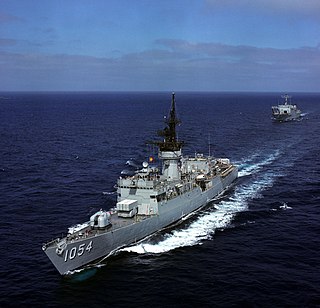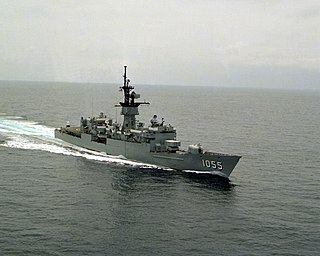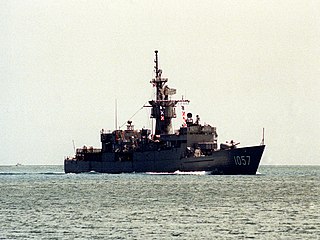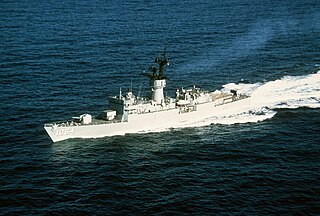
USS Knox (DE/FF-1052) was the lead ship of her class of destroyer escorts in the United States Navy. Knox was named for Commodore Dudley Wright Knox, and was the second US Navy ship named Knox. In 1975, she was redesignated a frigate. She served from 1969 to 1992, and was sunk as a target in 2007.

USS Miller (FF-1091), originally (DE-1091) was a Knox-class destroyer escort in the United States Navy. She was named for Cook Third Class Doris "Dorie" Miller, who was awarded the Navy Cross for his actions at the attack on Pearl Harbor.

USS Fanning (FF-1076), a Knox-class frigate, is the third ship of the United States Navy to be named for Nathaniel Fanning.

The Claud Jones-class destroyer escorts were four destroyer escorts built for the United States Navy in the late 1950s. These ships were a diesel-powered version of the earlier Dealey class and were designed with the aim of producing a cheaper ship suitable for rapid production in wartime. These ships also had reduced armament and speed compared to their predecessors. They were not seen as effective anti-submarine warfare vessels by the United States Navy and were sold after only 15 years service to the Indonesian Navy.

USS Downes (DE-1070/FF-1070) was the 19th in the series of the Knox-class frigates. She was the third ship to be named for Commodore John Downes

USS Gray (FF-1054) was a United States Navy Knox-class frigate. She was named for Marine Corps Sergeant Ross F. Gray, who was a posthumous recipient of the Medal of Honor.

USS Hepburn (FF-1055) was a United States Navy Knox-class frigate named for Arthur Japy Hepburn.

USS Rathburne (FF-1057) was a Knox-class frigate of the US Navy. Despite the different spelling, she was named for Continental Navy officer John Rathbun (1746-1782).

USS Reasoner (FF-1063) was a Knox-class frigate of the United States Navy, named in honor of 1st Lt. Frank S. Reasoner, awarded the Medal of Honor posthumously in the Vietnam War.

USS Lockwood (FF-1064) was the 13th Knox-class destroyer escort, redesignated a frigate in 1975. She was named for Charles A. Lockwood.

USS Francis Hammond (DE/FF-1067) is the sixteenth Knox-class frigate, named in honor of Hospitalman Francis Colton Hammond, a Medal of Honor recipient.

USS Robert E. Peary (FF-1073) was a Knox-class frigate that saw service with the United States Navy from 1972 until 1992. In 1992, the ship was decommissioned and loaned to the Republic of China. The ship was renamed Chi Yang and served in the Taiwanese navy until 2015.

USS Donald B. Beary (FF-1085) was a Knox-class frigate built for the United States Navy.

USS Brewton (FF-1086) is a Knox-class frigate of the United States Navy and the first ship of her name. She is currently in service with the Republic of China Navy as the ROCS Fong Yang (FFG-933).

HNLMS Van Speijk (F802) was a frigate of the Van Speijk class. The ship was in service with the Royal Netherlands Navy from 1967 to 1986. The ship's radio call sign was "PAVA". She was sold to the Indonesian Navy where the ship was renamed KRI Slamet Riyadi (352). The ship was decommissioned in 2019.

KRI Oswald Siahaan (354) is an Ahmad Yani-class frigate operated by the Indonesian Navy. Prior to her service in the Indonesian Navy, she served in the Royal Netherlands Navy as Van Speijk-class frigateHNLMS Van Nes (F805).

HNLMS Evertsen (F815) was a frigate of the Van Speijk class. The ship was in service with the Royal Netherlands Navy from 1967 to 1989. The ship's radio call sign was "PAVG". She was sold to the Indonesian Navy where the ship was renamed KRI Abdul Halim Perdanakusuma (355).

HNLMS Isaac Sweers (F814) is a frigate of the Van Speijk class. The ship was in service with the Royal Netherlands Navy from 1968 to 1990. The ship's radio call sign was "PAVF". She was sold to the Indonesian Navy where the ship was renamed KRI Karel Satsuitubun (356).

Nikolay Kartashov was a Don-class submarine tender of the Soviet Navy which later was transferred to the Indonesian Navy and renamed KRI Ratulangi.

KRI Teluk Banten (516) is the fifth Teluk Semangka-class tank landing ship of the Indonesian Navy.




















